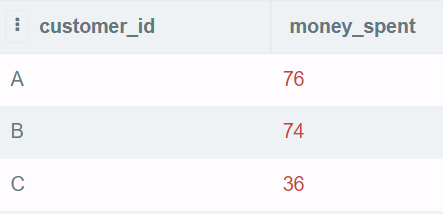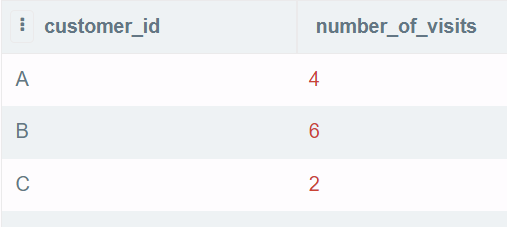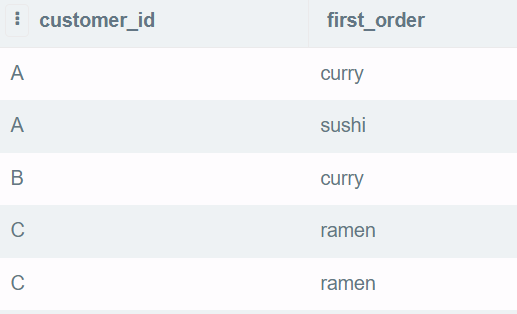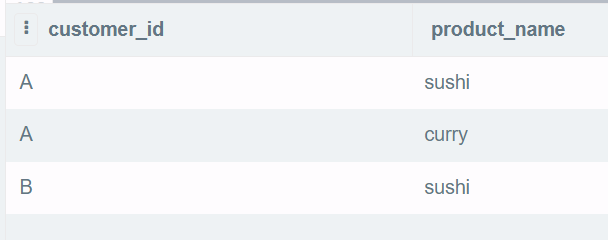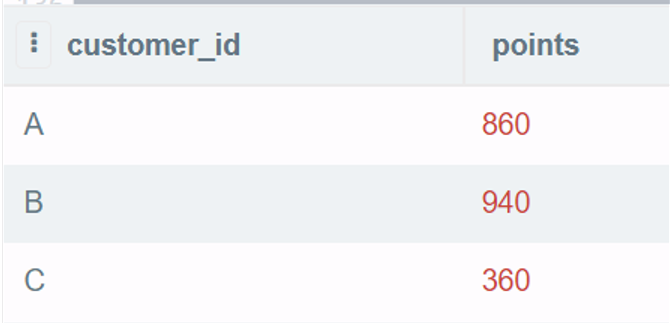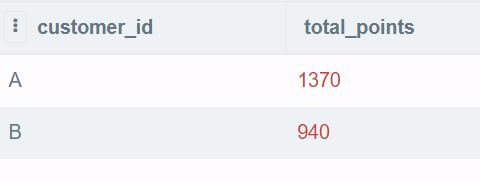Learning Objective
I used PostgreSQL to tackle this case study, mainly focusing on following functions:
- Common Table Expressions
- Group By Aggregates
- Window Functions for ranking
- Case When
- Table Joins
Introduction
Danny seriously loves Japanese food so in the beginning of 2021, he decides to embark upon a risky venture and opens up a cute little restaurant that sells his 3 favourite foods: sushi, curry and ramen.
Danny’s Diner is in need of your assistance to help the restaurant stay afloat - the restaurant has captured some very basic data from their few months of operation but have no idea how to use their data to help them run the business.
Problem Statement
Danny wants to use the data to answer a few simple questions about his customers:
- their visiting patterns,
- how much money they’ve spent,
- which menu items are their favourite
Having this deeper connection with his customers will help him deliver a better and more personalised experience for his loyal customers.
He plans on using these insights to help him decide whether he should expand the existing customer loyalty program - additionally he needs help to generate some basic datasets so his team can easily inspect the data without needing to use SQL.
All datasets exist within the dannys_diner database schema. Danny has shared with you 3 key datasets for this case study:
salesmenumembers
Table 1: sales
The sales table captures all customer_id level purchases with an corresponding order_date and product_id information for when and what menu items were ordered.
| customer_id | order_date | product_id |
|---|---|---|
| A | 2021-01-01 | 1 |
| A | 2021-01-01 | 2 |
| A | 2021-01-07 | 2 |
| A | 2021-01-10 | 3 |
| A | 2021-01-11 | 3 |
| A | 2021-01-11 | 3 |
| B | 2021-01-01 | 2 |
| B | 2021-01-02 | 2 |
| B | 2021-01-04 | 1 |
| B | 2021-01-11 | 1 |
| B | 2021-01-16 | 3 |
| B | 2021-02-01 | 3 |
| C | 2021-01-01 | 3 |
| C | 2021-01-01 | 3 |
| C | 2021-01-07 | 3 |
Table 2: menu
The menu table maps the product_id to the actual product_name and price of each menu item.
| product_id | product_name | price |
|---|---|---|
| 1 | sushi | 10 |
| 2 | curry | 15 |
| 3 | ramen | 12 |
Table 3: members
The final members table captures the join_date when a customer_id joined the beta version of the Danny’s Diner loyalty program.
| customer_id | join_date |
|---|---|
| A | 2021-01-07 |
| B | 2021-01-09 |
Case Study Questions & My Solutions
- What is the total amount each customer spent at the restaurant?
SELECT S.CUSTOMER_ID, SUM(M.PRICE) AS MONEY_SPENT
FROM DANNYS_DINER.SALES AS S
LEFT JOIN DANNYS_DINER.MENU AS M
USING (PRODUCT_ID)
GROUP BY 1
ORDER BY 1
- How many days has each customer visited the restaurant?
SELECT customer_id, COUNT(DISTINCT(order_date)) AS NUMBER_OF_VISITS
FROM DANNYS_DINER.SALES
GROUP BY 1
ORDER BY 1
- What was the first item from the menu purchased by each customer?
WITH first_item_purchase AS (
SELECT S.customer_id, M.product_name, S.order_date,
DENSE_RANK () OVER (PARTITION BY S.CUSTOMER_ID ORDER BY S.ORDER_DATE) AS rank_by_orderdate
FROM DANNYS_DINER.SALES AS S
LEFT JOIN DANNYS_DINER.MENU AS M
USING (product_id)
)
SELECT customer_id, product_name AS first_order
FROM first_item_purchase
WHERE rank_by_orderdate = 1
- What is the most purchased item on the menu and how many times was it purchased by all customers?
SELECT M.product_name as most_purchased_item, COUNT(S.product_id) AS count_of_orders
FROM DANNYS_DINER.SALES AS S
LEFT JOIN DANNYS_DINER.MENU AS M
USING (product_id)
GROUP by 1
ORDER by COUNT(S.product_id) DESC
LIMIT 1
- Which item was the most popular for each customer?
WITH MOST_POPULAR_ITEM AS (
SELECT S.customer_id, M.PRODUCT_NAME, COUNT(S.product_id) AS PURCHASE_COUNT,
RANK () OVER (PARTITION BY S.customer_id ORDER BY count(S.product_id) DESC)
FROM DANNYS_DINER.SALES AS S
LEFT JOIN DANNYS_DINER.MENU AS M
USING (product_id)
GROUP BY 1, 2
)
SELECT customer_id, product_name, purchase_count
FROM MOST_POPULAR_ITEM
WHERE RANK = 1
- Which item was purchased first by the customer after they became a member?
WITH FIRST_MEMBER_PURCHASE AS (
SELECT S.CUSTOMER_ID, S.ORDER_DATE, M.PRODUCT_NAME,
DENSE_RANK () OVER (PARTITION BY S.customer_id ORDER BY S.ORDER_DATE) AS RANK_BY_ORDER_DATE
FROM DANNYS_DINER.SALES AS S
LEFT JOIN DANNYS_DINER.MEMBERS AS MEM
USING (customer_id)
LEFT JOIN DANNYS_DINER.MENU AS M
USING (product_id)
WHERE S.ORDER_DATE >= MEM.JOIN_DATE
)
SELECT customer_id, product_name
FROM FIRST_MEMBER_PURCHASE
WHERE RANK_BY_ORDER_DATE = 1
- Which item was purchased just before the customer became a member?
WITH LAST_NON_MEMBER_PURCHASE AS (
SELECT S.CUSTOMER_ID, S.ORDER_DATE, M.PRODUCT_NAME,
DENSE_RANK () OVER (PARTITION BY S.customer_id ORDER BY S.ORDER_DATE DESC) AS RANK_BY_ORDER_DATE
FROM DANNYS_DINER.SALES AS S
LEFT JOIN DANNYS_DINER.MEMBERS AS MEM
USING (customer_id)
LEFT JOIN DANNYS_DINER.MENU AS M
USING (product_id)
WHERE S.ORDER_DATE < MEM.JOIN_DATE
)
SELECT customer_id, product_name
FROM LAST_NON_MEMBER_PURCHASE
WHERE RANK_BY_ORDER_DATE = 1
- What is the total items and amount spent for each member before they became a member?
SELECT S.customer_id, COUNT(S.PRODUCT_ID) AS TOTAL_ITEMS, SUM(M.PRICE) AS AMOUNT_SPENT
FROM DANNYS_DINER.SALES AS S
LEFT JOIN DANNYS_DINER.MENU AS M
USING (product_id)
LEFT JOIN DANNYS_DINER.MEMBERS AS MEM
USING (customer_id)
WHERE S.ORDER_DATE < MEM.JOIN_DATE
GROUP BY S.CUSTOMER_ID
- If each $1 spent equates to 10 points and sushi has a 2x points multiplier - how many points would each customer have?
SELECT S.customer_id,
SUM(CASE WHEN M.PRODUCT_NAME = 'sushi' then m.price*20
else m.price*10
end) AS points
FROM DANNYS_DINER.SALES AS S
LEFT JOIN DANNYS_DINER.MENU AS M
USING (product_id)
GROUP by 1
ORDER by 1
- In the first week after a customer joins the program (including their join date) they earn 2x points on all items, not just sushi - how many points do customer A and B have at the end of January?
SELECT S.CUSTOMER_ID,
SUM(CASE WHEN S.ORDER_DATE BETWEEN MEM.JOIN_DATE AND MEM.JOIN_DATE+6 THEN M.PRICE*20
when m.product_name = 'sushi' then m.price*20
ELSE M.PRICE*10
END) AS total_points
FROM DANNYS_DINER.members AS MEM
LEFT JOIN DANNYS_DINER.SALES AS S
USING (customer_id)
LEFT JOIN DANNYS_DINER.MENU AS M
USING (product_id)
GROUP BY 1
ORDER BY 1
Final Thoughts
This is my first SQL Case Study, absolutely loved it! Thank you Danny for creating these case studies to help SQL-learners (like myself) apply their theoratical knowledge into pratice.
